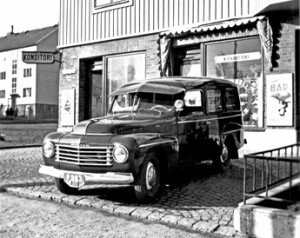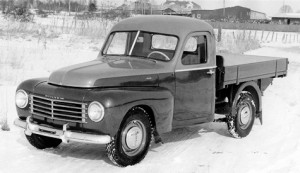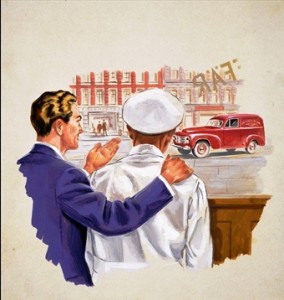
A typical 445 van, designed for light goods delivery service in urban areas. This one delivered cakes.
Volvo, like most makers of its day, offered a chassis cab model, which could then be converted to a wide variety of custom uses. In Sweden this happened shortly after Volvo started making cars in 1927. These Volvo cars were still built on separate frames after Word War II, so the chassis versions were offered throughout the 1950s. But these were large, heavy vehicles.
The postwar PV444 sedan from Volvo was smaller and more fuel efficient due to its unit-body design, which presented a problem for converters. So a commercial version using the running gear but built with a separate frame debuted in the summer of 1949.
In the U.S. at about the same time the Ford F100 pickup with the same payload was appearing as a dedicated, rather than converted vehicle.
The 445 was the equivalent of the PV444 in size and price. When it came to design, the front fenders and hood came straight from the 444, but the 445 was distinguished from the sedan by having a grille with five horizontal chrome bars instead of four – the more automotive marketing changes, the more it remains the same.
The mechanics and equipment were all PV444, except for the rear axle, which, in the time-tested traditions of truck design, was sprung by two semi-elliptic leaf springs, instead of the more comfort-oriented coil-spring suspension of the 444.
Payload was up to 1,100 pounds (500 kg), depending on the body version. A pickup was lighter and could carry more weight than a heavier panel van. Total weight was 1650 kg and the chassis counted for 725 kg. And, as found by all other companies, customers soon learned that over-loading was possible without ill effects.
The 445’s 1.4 liter, four-cylinder was rated at 40 horsepower, adequate for city use, and it proved durable. Hauling ability at this small output came from low gearing, which meant engine noise and rocketing fuel consumption at higher speeds.
Sweden at this time had about 70 coach building companies. Some 25 did different bodywork for the 445, according to Volvo. For vans, hearses and ambulances, the bodies were made from wooden frames with sheet steel paneling, so were the cabs of the pickups. Very few all-steel bodies and cabs were ever made. The insides were basic. Some type of wood was used for the door sides, and the upholstery was artificial leather like.
Finally, a Dedicated Van
By the beginning of 1952, Volvo found itself with 1,500 unsold 445 delivery chassis parked outside the factory, as another trend emerged that any observer of Henry Ford could have predicted. The coach building days for basic vehicles were coming to a close as it was too expensive.
“Build our own Volvo van” was managing director’s Gabrielsson’s directive and thus was born the Volvo Duett – Volvo’s first van/estate (station wagon) model. Young engineer, Erik Skoog, and his small team designed a body for the 445 chassis that was suitable for both goods and people transport alike, ordered the necessary tools and – only 15 months later – on the 4th of July 1953, delivered the first Duett to its “customer,” Volvo president Assar Gabrielsson. Duet was meant to convey the dual aspects of the vehicle – it could be used for work or normal driving on weekends. Duet production lasted until 1969.
During its last year production year, Sweden introduced crash test requirements. With a design dating from the late 1940s, the Duett couldn’t comply, so all but one example of the 1969 Duetts were exported. The remaining car, chassis number 97299, is on display in the Volvo Museum today. Total production was 101,492 of all types.
The Duett was replaced by the 145 estate, which evolved down to this day as the 240, 850 and finally the V70 model.


